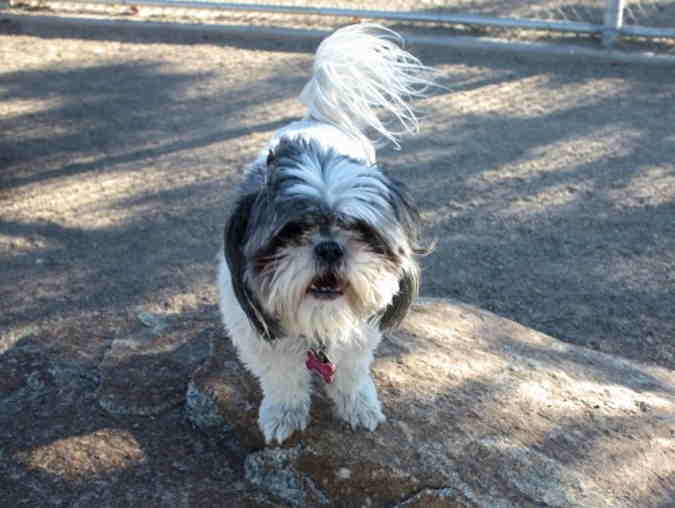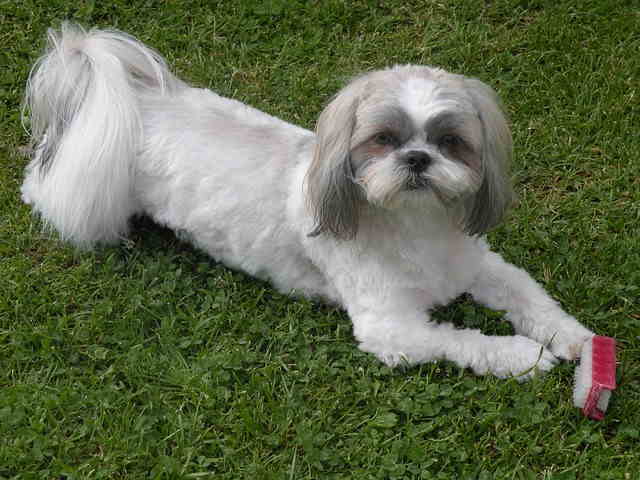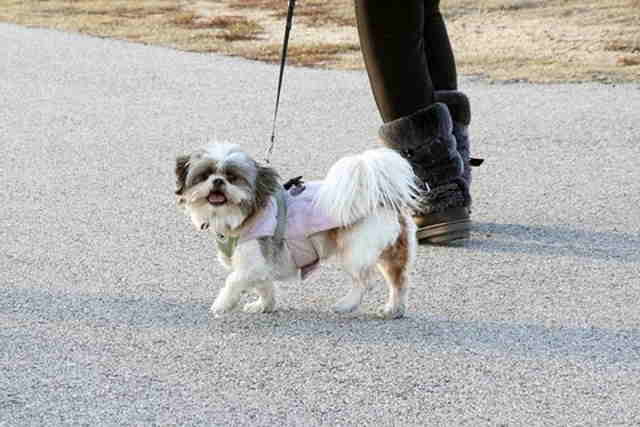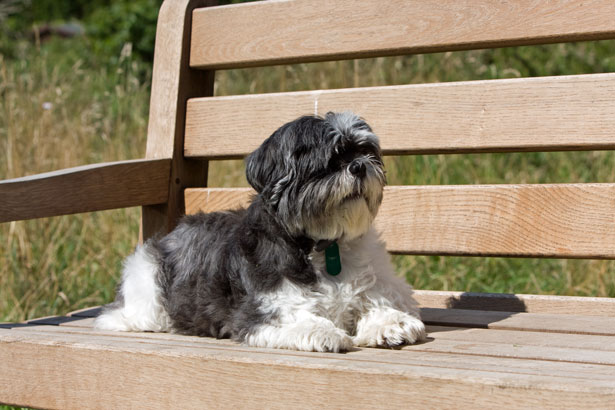How To Train Your Shih Tzu Dog the Right Way: 6 Basic Training Commands
By Everything Shih Tzu Updated January 5, 2023
This post may contain affiliate links. Read privacy & disclosure policy for info
Training a Shih Tzu puppy can be a challenging but ultimately rewarding experience and a great way to bond with your pet.
 Basic dog training commands
Basic dog training commandsTaking the time to teach your puppy obedience commands and proper behavior not only helps you form a better bond with them but also lays the foundation for an obedient and well-behaved pet that’s safe to take in public places.
Here you will learn the basic dog training commands such as:
- sit,
- stay,
- come,
- leave it,
- down,
- and heel
These 6 basic commands are the foundation for successful training, as well as positive reinforcement techniques like praise and treats, which will help encourage good behavior.
Finally, we'll cover common mistakes to avoid while training so that you can ensure successful results.
Get your dog, and some treats and keep reading to learn how to do each of the basic commands.
Basic Commands Used To Train Your Dog
Training your dog is important because it helps to create a strong bond between you and your pet, while also establishing boundaries that help keep them safe.
Not only this but teaching your dog to listen to your commands can also help to prevent unwanted behaviors from developing, such as excessive barking or jumping.
There are six main commands to teach them: sit, stay, come, leave it, down, and heel.
These six commands will help your pup know what to do in different situations.
Let's start with the "sit" command.
Teaching Your Dog The Sit Command
The sit command is often one of the first to teach your Shih Tzu. This teaches them that they can’t just go off and do whatever they want.
How To Train Your Dog to Sit
- Place a treat between your thumb and forefinger with your palm facing up.
- Place it directly in front of his nose until he focuses on it.
- Move you hand slowly over his head towards the base of his tail.
- As soon as his bottom hits the ground, mark the behavior with a clicker or marker word like "yes" or "good boy" and give him the treat.
- Once he consistently sits, try mimicking the same hand gesture without his reward between your fingers.
- Gradually adjust your hand luring so that the final hand signal for sit will be a flat palm facing up, raising it up about two to three inches.
- When he responds to the hand signal, then add in the verbal cue of “Sit.”
Once your dog has mastered the sit command in the privacy and comfort of your home, go out into a more public area, where there is lots of commotion, and work with your dog through the many distractions you'll come across. Be sure to always keep them on a leash while training in public.
Remember, his focus should always be on you, even when there is a silly squirrel bouncing around him to tempt his curiosity.
Once you have a good foundation with this command, take it to the next level by not giving a treat every single time he does what you ask.
Treats are used to encourage good behavior, but you don't want your dog to become dependent on them for a job well done.
The ultimate goal is he must understand that he should always listen to you whether he gets a yummy treat or not.
In the beginning use treats 100% of the time, then gradually reduce the using the treat when your dog responds to your cues nearly every time.
You can use other form of rewards too, like a little scratch under his chin, or a simple voice reward as positive reinforcement on the times he doesn't get a treat.
When you can get your dog to sit, even though he may or may not get a treat, you'll know he's mastered the "sit." Good boy!
Congratulations! It's time to teach him how to stay put when told.
 Basic dog training command for "sit"
Basic dog training command for "sit"Stay Command
The stay command is also important in your Shih Tzu training.
This will help your puppy learn to wait for permission before moving from one place to another.
- Start with him in a sitting position.
- Place your hand, flat palm, in front of him like a stop sign. Hold this position for 1 second. Mark the behavior and use a treat to lure him out of the sitting position to release him from the stay. If at any point he breaks the stay before you tell him to, reset and try again.
- As he is responding consistently, slowly start adding more and more time to the stay. Use small increments, 2 seconds, 5 seconds, 10 seconds, 15 seconds, 20 seconds, 30 seconds, etc.
- When he will consistently stay for 30 seconds, then switch to practicing distance. Step one foot away from him and then immediately back. Mark and release him.
- Slowly increase the distance between you and your Shih Tzu by taking adding a step away after each successful stay.
- Once you have reached 10 steps away from your dog, you can add distance and duration together. Take one step away from him, wait a few seconds and then step back to him, mark and release.
When your dog is consistently responding to duration and distance, you can start adding distractions, such as tossing a tennis ball or being in new environments.
Just remember that when you add in distractions, reduce the distance and duration of your stay to set your puppy up for success.
Come Command

Before getting into how to implement this command, here are some noteworthy tips to help train your Shih Tzu to come to you:
- Keep the cue positive. You always want him to be excited to come to you
- Do not use the recall word if you know he won’t respond. Try calling his name first to see if he will react to you.
- Use extremely high-value food for recall. Find something your dog LOVES, like diced chicken or meatball, and use that only for working with recall.
- If he gets distracted after you’ve called him, go to him and use the food to lure him back to where you originally called him from. Make sure he learns to go to where you called him.
- Never chase your dog. This will only cause him to run away from you. If you need him to follow you and the recall won’t work, try walking in the opposite direction from him to get him to come to you.
Training your Shih Tzu to come to you can be challenging but absolutely essential, as it could keep them from potential danger if they ever get away from you.
It's also important to be aware that all dogs learn differently, so the steps outlined here may not work for every puppy.
That being said, there are certain techniques that are known to be effective in teaching your dog to come when called.
Here are six steps you can take to help your dog learn the command "come."
- Start by having your dog on a leash in an enclosed space with few distractions. The best way to start is with a quiet area, such as inside your home or in a fenced-in backyard.
- Show your dog a high-value treat and say “come” in an encouraging voice. Give them time to process the command and make sure they are looking at you.
- As soon as your Shih Tzu starts to come towards you, use a marker word and give them the treat.
- After a few successful repetitions, start adding distance by taking a few steps away from your dog while still holding the leash. Say “come” as you move away, and give them another treat when they reach you.
- Gradually increase the distance between yourself and your Shih Tzu until they are coming from across the room or yard without hesitation.
- Once your pup is able to consistently respond to the “come” command from a distance, practice off-leash training in an enclosed area. Be sure to offer lots of praise and treats for coming when called.
Remember that positive reinforcement is key when it comes to training your pup. If they are not responding correctly to the “come” command, try rewarding them with verbal praise instead of treats.
And if things don’t seem to be going as planned, take a break and come back to it another day.
With patience and consistency, your dog will eventually learn the command “come.”
Leave It Command

Using the "leave it" command is important when training a dog to pay attention and respect boundaries.
This command can help prevent a dog from ingesting potentially dangerous items, such as spoiled food or hazardous materials.
It also teaches the dog impulse control, which can be useful in many situations, such as when there are strangers around or during walks.
Additionally, this command helps them to understand that they must wait for permission before taking something they want.
Thus, teaching the "leave it" command is essential if you want your dog to maintain good behavior and stay safe in any environment.
Steps to teaching a dog to "leave it"
Start with two different types of rewards, something low value for the leave it commands and your regular training reward.
Your low-value item can even be plain kibble to start out.
The most important thing to remember is that your dog should never get the 'Leave It' item.
- Place the low-value item in your hand and tell him to "Leave it." Every time he goes for it, cover it with your hand. (You only need to say "leave it" once. Just cover it with your hand.)
- As soon as he looks away from the treat, mark the behavior and reinforce him with his regular training treats.
- Once he is consistently responding to "leave it," make the behavior harder by placing the treat on the ground and covering it with your hand each time he goes for it.
- To make the behavior even harder, drop it on the ground and cover it with your foot.
Learning how to use the “leave it” command is essential for
successful Shih Tzu training.
It can help your dog understand boundaries, prevent them from getting into risky situations and encourage them to wait for permission before taking something.
Above all, it reinforces your role as the leader in their life and helps them to understand that you are in charge.
Teaching Your Dog the Down or Off Command
 Down command
Down commandUsing the “off” or “down” command is imperative when you want your Shih Tzu to be well-behaved in society.
It teaches dogs to stop jumping on people or furniture when they get excited and to stay off countertops or other objects they shouldn't be on.
Additionally, teaching your dog the "off" command can help them understand that certain behaviors are unacceptable and that they need to stay down.
By following the steps outlined below, you can successfully teach your pup the "off" command in just a few sessions.
Remember to remain consistent with your training and always provide positive reinforcement for good behavior. With patience and dedication, you’ll have a well-trained pup in no time!
Here are the steps for the down command:
- Start by selecting a word that you would like to use as the off command. Make sure it is a single-syllable word that your dog can recognize easily. For example, you may choose the word “off” or “down.”
- Begin teaching your dog the command with them in a sitting position. Show them the treat and bring it up to their nose. As your dog reaches for the treat, gently guide their head toward the ground by pulling down on their collar or harness.
- As soon as your pup is in a laying position, say “off” or "down" and reward them with the treat. Repeat this process several times.
- You can begin increasing the difficulty of the command by adding a verbal cue before you give them their treat. For example, say “off” and wait a few seconds before giving your pup the reward.
- As your pup starts to understand the off command, try using it in different situations. For example, if your pup jumps on furniture or people, say “off” and guide them to the floor before rewarding them with a treat.
- As always, be sure to offer lots of praise for good behavior and patience in new situations. With practice and consistency, your pup will learn the off command in no time!
Heel Command

The heel command is an important tool for Shih Tzu owners since it teaches them to stay in a specific position relative to the owner, and not pull on their leash
For example, when walking your dog, it is essential that they remain at your side and not ahead of you or lag behind.
Teaching them to heel allows you to maintain control over the situation and keep your pet safe.
- Start with him sitting next to you. Tell them “heel” and begin walking.
- Anytime his front legs are not parallel to your legs, stop and have him sit and start again.
- Periodically, when he is walking next to you, mark and reward the behavior. You can try slathering peanut butter on a wooden spoon and offer him a few licks as a reward, instead of leaning down to Shih Tzu height.
The Importance of Positive Reinforcement
Positive reinforcement is essential for successful training.
It’s important to give your dog praise or a treat whenever they do something correctly. This will help them understand that they’ve done the right thing and encourage them to repeat it in the future.
You can also use treats to reward good behavior during training sessions, such as sitting when asked or staying still for a certain amount of time.
It’s necessary to remember that the treats should be given sparingly and not every single time they do something correctly.
The goal is to create a positive, rewarding environment rather than one where they are expecting a treat every time.
Common Mistakes to Avoid While Training Your Dog
Training a dog can often be a challenge, but there are some common mistakes that can make the process even more difficult.
Here’s what you should avoid when training your pup:
- Not being consistent with commands. Make sure you use the same word or phrase each time, and be consistent in how you reward them.
- Yelling or being too harsh. It’s important to stay calm and use a gentle tone of voice.
- Not staying patient. Successful training takes time, so it’s important to remain patient and not give up if they don’t seem to be getting it right away.
- Getting frustrated or angry with your pup. It’s important to stay positive and focus on rewarding good behavior.
By avoiding these mistakes, you can ensure successful results when training your pup.
A Final Word About Basic Dog Training
Dog training builds upon itself, and once you've mastered these key commands, you can use these skills for a variety of
tricks and advanced training.
Training your Shih Tzu is equal parts training and persistence.
Once you’ve mastered the basic dog training commands and have found the way to work with him instead of against him, there’s an endless world of training possibilities.
Happy Trainings!



